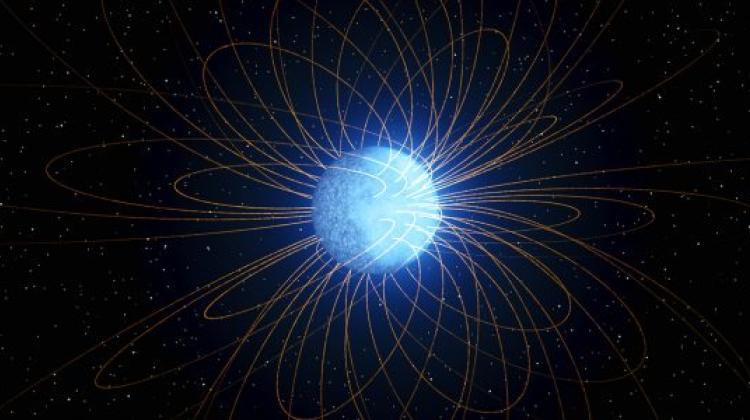Astronomers discover 'two-faced' star
 An artist's impression of the magnetic field around a white dwarf. Source: Caltech
An artist's impression of the magnetic field around a white dwarf. Source: Caltech
An international team of astronomers in Nature has announced the discovery of an unusual white dwarf star that is made of hydrogen on one side and helium on the other. Dr Przemysław Mróz from the Astronomical Observatory of the University of Warsaw is a co-author of the study.
The object was named Janus, after the Roman god of transition, who was depicted as a two-faced deity.
The star was discovered in data from the Zwicky Transient Facility (ZTF) sky survey, carried out at the Palomar Observatory in California. Dr. Przemysław Mróz from the Astronomical Observatory of the University of Warsaw was responsible for measuring the brightness of over a billion stars observed by the ZTF project, thanks to which this unusual object was found, the University of Warsaw reports in a release on its website.
'The object stood out for its rapid changes in brightness that repeat every 15 minutes. This is the time of its one revolution around its axis', says Dr. Przemysław Mróz, quoted in the release.
White dwarfs are the scalding remains of stars that were once like our Sun. 'As the stars age, they puff up into red giants, but eventually their outer fluffy material is blown away and their cores contract into dense, fiery-hot white dwarfs', the Polish astronomer explains.
White dwarfs have masses similar to the mass of the Sun, but they are a hundred times smaller and a million times denser. One teaspoon of white dwarf matter can weigh as much as a passenger car.
Additional observations made with the W. M. Keck Observatory atop Maunakea in Hawaii revealed the dramatic double-faced nature of the white dwarf. The scientists used an instrument called a spectrometer to spread the light of the white dwarf into a rainbow of wavelengths that contain chemical fingerprints. The data revealed the presence of hydrogen only when one side of the object was in view, and only helium when the other side swung into view.
'It is assumed that the atmospheres of some white dwarfs change from completely hydrogen to completely helium. Due to the high density, and therefore strong gravity, heavy elements fall into the centre of the white dwarf. Hydrogen is the lightest of all elements and floats on the surface. However, it is believed that over time, when the white dwarf cools down, layers of hydrogen and helium on the star's surface should mix. Janus is probably the first object in which this phenomenon has been directly observed', explains Dr. Mróz.
The reason for such significant differences in the chemical composition of the surface is not known. Scientists speculate that the magnetic field may hold the key to explaining them.
Magnetic fields around cosmic bodies tend to be asymmetric, or stronger on one side,” says Ilaria Caiazzo, a postdoctoral scholar at the California Institute of Technology and first author of the paper in Nature (https://www.nature.com/articles/s41586-023-06171-9). 'Magnetic fields can prevent the mixing of materials. So, if the magnetic field is stronger on one side, then that side would have less mixing and thus more hydrogen,” she adds.
According to another theory proposed by the team, magnetic fields can affect the pressure and density of the atmospheric gases.
'The magnetic fields may lead to lower gas pressures in the atmosphere, and this may allow a hydrogen +ocean+ to form where the magnetic fields are strongest', says James Fuller, co-author of the publication and professor of theoretical astrophysics at Caltech.
Testing these hypotheses requires a larger sample of similar objects. Scientists hope that data from future large sky surveys will provide it. (PAP)
agt/ bar/ kap/
tr. RL
Przed dodaniem komentarza prosimy o zapoznanie z Regulaminem forum serwisu Nauka w Polsce.















